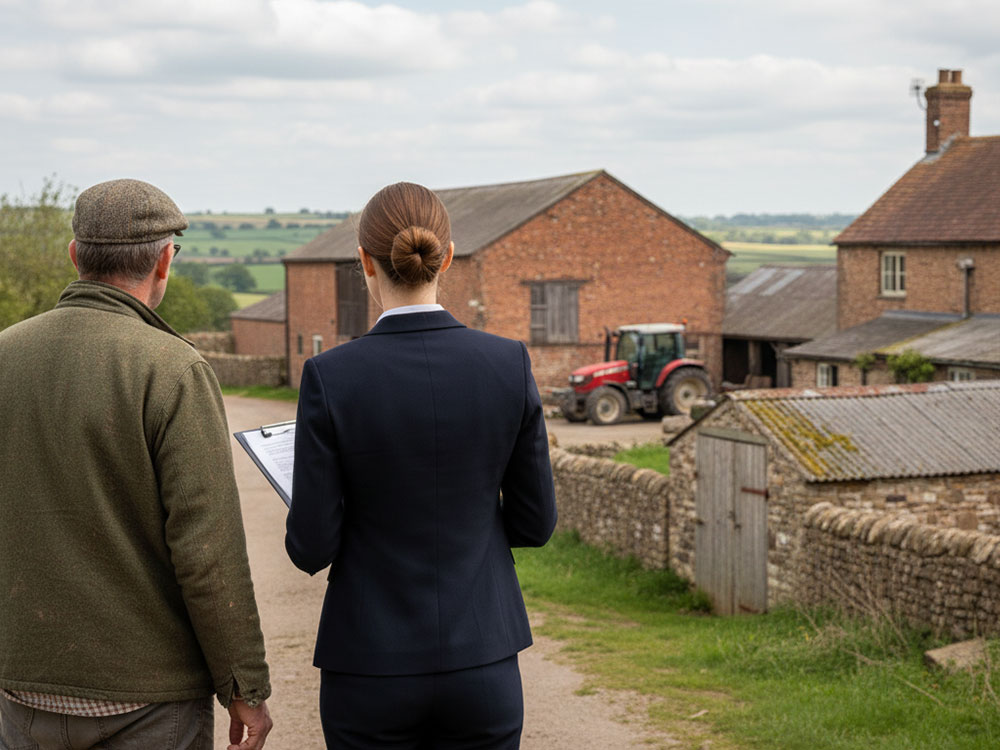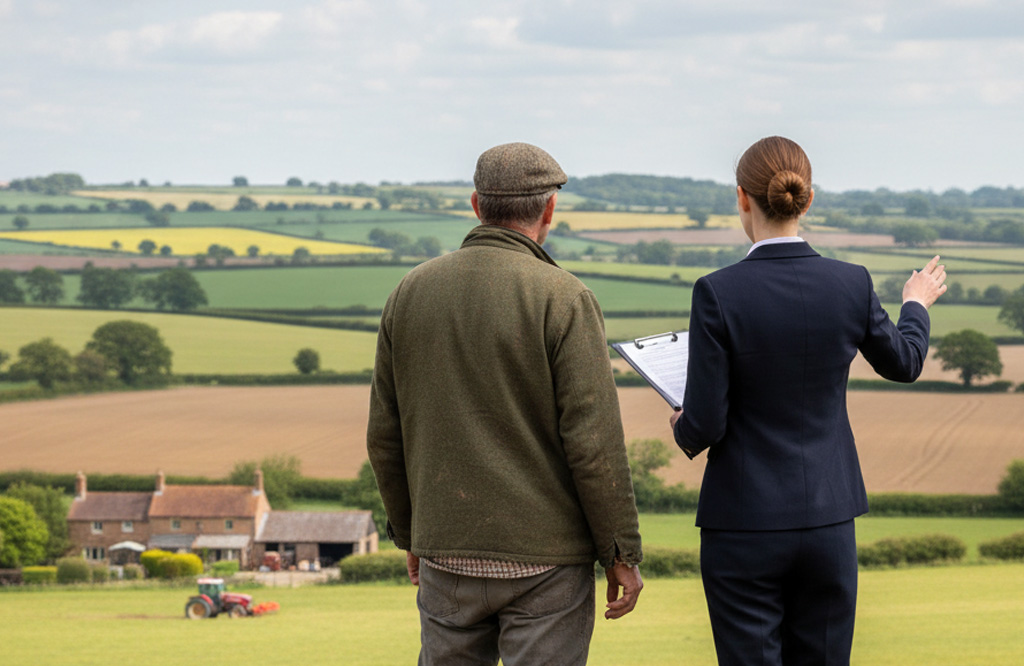Agricultural land is one of the UK’s most resilient and misunderstood asset classes. It is bought, sold, inherited, and speculated on daily – yet few landowners truly understand its potential. When people search for the value of agricultural land per acre, they often want a neat number. But the truth? That figure tells you the price today, not the wealth hidden beneath your soil tomorrow.
At Intelligent Land, we exist to bridge that gap. With over 30 years of planning expertise and our proprietary Land Value Accelerator™ (LVA Method™), we uncover hidden millions that others overlook. What others might value at £10,000 per acre, we often reposition at £100,000, £250,000 or even £500,000 per acre. This guide is designed to give you the full picture – not just what farmland is worth now, but how to maximise its potential.
Why Agricultural Land Value Matters
If you own farmland, its value isn’t just an abstract number – it shapes your financial security, your family’s legacy, and your options for the future. Yet many landowners underestimate its importance.
Common Fears and Misconceptions
“It’s only worth what the agent/market says per acre.”
Wrong. That figure is a snapshot, not a strategy.
“Planning takes decades – I’ll never benefit.”
Not if you know where to look. Uplifts can happen in days.
“Policy changes will wipe out value.”
With the right foresight, regulation can become an opportunity.
Ignoring land value, whether grazing land value, or land for new builds, is costly. The biggest risk is not what you do – it’s what you don’t do. Every year, owners lose millions simply because they never explored their true options.
What Is the Value of Agricultural Land?
Current Benchmarks
The average value of agricultural land in the UK typically falls between £6,000 and £12,000 per acre.
- Arable land value per acre: £8,000–£12,000.
- Grazing land value per acre: £6,000–£9,000.
- Farm land value per acre: £7,000–£10,000 for mixed use.
Small parcels can fetch more. The value of 1 acre of agricultural land near towns often exceeds £15,000 due to pony paddock and amenity demand.
Regional Differences
- South East & London fringe: consistently above £10,000 per acre due to development pressure.
- Midlands: mixed, with Grade 1 soils commanding premiums.
- North & Wales: averages closer to £6,000–£8,000 per acre.
- Scotland: wide range – from £3,500 hill grazing land to £12,000 premium arable.
Historic Trends
Over the last 20 years, farmland values have risen more than 250%, outperforming many asset classes. Short-term dips (e.g., 2008, 2016) were temporary, with long-term scarcity driving upward growth.
Future Outlook
- BNG and carbon credits will underpin demand.
- Food security concerns could push values higher.
- Interest rate cycles may cause volatility but not erase long-term appreciation.
Read more: How to Value Agricultural Land

Beyond the Acre: What Really Drives Agricultural Land Value
The value of farm land per acre is shaped by multiple interlocking drivers:
- Location & Accessibility – Edge-of-settlement land often carries “hope value.”
- Soil Quality – Grade 1 and 2 soils command premiums, but poor soils may have environmental value.
- Planning Status – The biggest multiplier. Land with planning can leap from £10k/acre to £500k+/acre.
- Diversification Potential – Solar, glamping, equestrian, or storage uses transform values.
- Environmental Credits – Biodiversity Net Gain (BNG) and carbon trading are new markets for farmland.
- Policy Landscape – Schemes like ELMS/SANG/ANRG reshape incentives.
- Market Timing – Interest rates, food security, and investor demand all shift values.
Same acreage, same soil, two different contexts – and two wildly different outcomes relating to agricultural land value.
Planning, Permissions and Hope Value
Hope value is the market’s expectation that land may one day gain planning permission. It explains why two identical fields can have 10x difference in valuation.
- Bare farmland: £7,000–£10,000 per acre.
- Land with realistic hope value: £100,000–£500,000+ per acre.
But hope value is dangerous if misunderstood. Overestimate it, and you overpay. Underestimate it, and you walk away from millions.
Risks of Hope Value
- Speculative Overpayment – buying into false assumptions.
- Delays – planning refusals can stall value for decades.
- Tax Traps – inflated inheritance calculations create liabilities.
- Illiquidity – land stuck in limbo is hard to sell.
From Hope to Certainty
This is where Intelligent Land’s LVA Method™ transforms outcomes:
- Review Planning Permissions – uncovering hidden rights.
- Undertake Research – ESG, biodiversity, and legal analysis.
- Scenario Testing – AI models thousands of outcomes for clarity.
Read more: Understanding Hope Value on Agricultural Land
Permitted Development and Its Impact on Value
Permitted Development Rights (PDRs) let landowners bypass full planning for certain works. They’re one of the most overlooked levers in maximising agricultural land value per acre.
Thresholds:
- Under 0.4 hectares – minimal rights.
- 0.4–5 hectares – limited rights (1,000m² cap).
- 5+ hectares – broad rights for large buildings and infrastructure.
Why It Matters
Used strategically, PDRs allow:
- New barns, silos, and infrastructure.
- Conversion to residential (Class Q).
- Flexible commercial use (Class R).
These can deliver £1m+ uplifts overnight. Yet many landowners miss them entirely.
Read more: Permitted Development on Agricultural Land Guide
Policy, BNG and ESG: The New Value Drivers
A decade ago, environmental policy was a constraint. Today, it’s an opportunity.
- Biodiversity Net Gain (BNG) – As of 2024, developers must deliver 10% BNG. Agricultural land suitable for habitat creation is now a high-value commodity.
- Carbon Markets – Woodland creation and soil carbon credits can generate new income streams.
- ESG Investing – Institutions pay premiums for land that meets sustainability goals.
The Policy Roadmap
- 2024 – BNG made mandatory for developments.
- 2025 to 2030 – ELMS rolls out across England, reshaping subsidies.
- 2030 onwards – Net Zero targets drive demand for land-based carbon sequestration.
Ignoring policy is no longer an option. With the right strategy, it’s a source of hidden millions.
Agricultural Land as an Investment
Investors increasingly ask: Is buying farm land a good investment?
Benefits
- Capital Growth – farmland has risen steadily for decades.
- Diversification – uncorrelated with stock markets.
- Tax Relief – APR reduces inheritance tax.
- Tangible Asset – land is physical, finite, and enduring.
Risks & Fears
- “What if subsidies vanish?” – Then diversification and BNG credits step in.
- “What if farming returns are low?” – Farming is only one layer; renewable energy or tourism can outperform.
- “What if policy shifts again?” – Our AI tracks regulation in real time to futureproof strategies.
Competitor Contrast
- Traditional Agents – provide a per-acre figure and market appraisal.
- Standard Consultants – navigate paperwork but rarely unlock uplift.
- Intelligent Land – reframes your land, models thousands of scenarios, and identifies £1m+ hidden value in days.
Read more: Agricultural Land Investment
How to Maximise the Value of Agricultural Land
Knowing the average value of agricultural land is the start. Maximising it is the endgame.
Key Levers
- Planning – securing permissions others overlook.
- Diversification – equestrian, glamping, renewables, storage.
- Environmental Credits – BNG and carbon markets.
- Repositioning – reframing land use to shift buyer perception.
Buyer Personas
- Farmers – want operational efficiency and diversification income.
- Investors – seek capital growth and alternative income streams.
- Inherited Landowners – need clarity on tax, legacy, and uplift.
- Developers – target land with uplift potential and reduced risk.
Each group benefits from Intelligent Land’s approach, but in different ways.
Read more: How to Value Agricultural Land
Case Studies: From Potential to Uplift
Case Study 1: 12 Acres of Pasture
- Agent’s valuation: £84,000.
- Our LVA Method™ identified biodiversity offsetting demand and renewable leasing potential.
- Outcome: £1.2m uplift.
Case Study 2: 25 Acres Edge of Settlement
- Dismissed as low-value grazing. We modelled BNG credits and potential residential allocation.
- Outcome: £3m valuation vs. £250k before.
These are not exceptions – they are what happens when you move from paperwork to outcomes.
The Intelligent Land Difference: The Land Value Accelerator™
Our LVA Method™ is designed for one outcome: unlocking hidden millions.
- Review Planning Permissions – assessing current baseline.
- Undertake Research – legal, technical, ESG, biodiversity.
- Scenario Testing – AI models thousands of scenarios to reveal the optimal path.
Outcomes
- Speed – uplifts identified in 24 hours.
- Certainty – evidence replaces speculation.
- Exclusivity – we work in partnership, not as a supplier.
FAQs on Agricultural Land Value
- What is the value of agricultural land per acre UK?
£7,000 to £10,000, but planning can multiply this value many times. - What is the value of farm land per acre for grazing?
£6,000–£9,000, often more near towns. - What is the average value of agricultural land UK?
Around £8,000, with wide regional variation. - Does planning permission increase farmland value?
Yes – sometimes 50x or more. - Can I increase the value of 1 acre of agricultural land?
Yes, through BNG, diversification, or planning. - Is small land ever worth more than big?
Yes. Amenity demand and location can drive premiums. - What are the biggest mistakes landowners make?
Relying on agent averages, ignoring planning, and missing ESG opportunities. - Can I sell farmland without planning uplift?
Yes, but you risk leaving millions behind. - Will policy changes reduce my land’s worth?
Not if anticipated strategically – Intelligent Land reframes them as opportunities. - What if my land is constrained by AONB or Green Belt?
Constraints limit some uses, but new value may be found in environmental credits.
Conclusion: From Land to Wealth
The value of agricultural land per acre is only the starting point. Real wealth is unlocked through strategy, foresight, and intelligent action.
Traditional consultants give you paperwork. Intelligent Land gives you outcomes.
If you own farmland, the question is not “What’s it worth today?” but “What could it be worth tomorrow?”
- Land Value Accelerator™ – Black-Box Insights, White-Glove Results.
Don’t let your neighbour find out before you do. Book a Land Value Accelerator™ assessment today – and unlock the hidden millions in your land.




